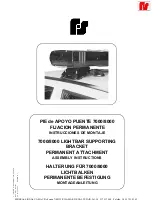
other obstacles. If it is necessary to drive over
kerbs, speed humps or similar elevations, try
to do so slowly and at an obtuse angle. Oth-
erwise, the tyres, particularly the sidewalls,
may be damaged.
Regular checking of wheels and tyres
G
WARNING
Damaged tyres can cause tyre inflation pres-
sure loss. As a result, you could lose control
of your vehicle. There is a risk of accident.
Check the tyres regularly for signs of damage
and replace any damaged tyres immediately.
Regularly check the wheels and tyres of your
vehicle for damage at least once a month, as
well as after driving off-road or on rough
roads. Damaged wheels can cause a loss of
tyre pressure. Pay particular attention to
damage such as:
R
cuts in the tyres
R
punctures
R
tears in the tyres
R
bulges on tyres
R
deformation or severe corrosion on wheels
Regularly check the tyre tread depth and the
condition of the tread across the whole width
of all tyres (
Y
page 355). If necessary, turn
the front wheels to full lock in order to inspect
the inner side of the tyre surface.
All wheels must have a valve cap to protect
the valve against dirt and moisture. Do not fit
anything onto the valve other than the stand-
ard valve cap or other valve caps approved by
Mercedes-Benz for your vehicle. Do not fit any
other valve caps or systems, e.g. tyre pres-
sure monitoring systems.
Regularly check the pressure of all the tyres,
particularly prior to long trips. Adjust the tyre
pressure as necessary (
Y
page 357).
Observe the notes on the emergency spare
wheel (
Y
page 377).
The service life of tyres depends on various
factors, including the following:
R
driving style
R
tyre pressure
R
tyre mileage
Tyre tread
G
WARNING
Insufficient tyre tread will reduce tyre trac-
tion. The tyre is no longer able to dissipate
water. This means that on wet road surfaces,
the risk of aquaplaning increases, in particular
where speed is not adapted to suit the driving
conditions. There is a risk of accident.
If the tyre pressure is too high or too low, tyres
may exhibit different levels of wear at differ-
ent locations on the tyre tread. Thus, you
should regularly check the tread depth and
the condition of the tread across the entire
width of all tyres.
Minimum tyre tread depth for:
R
summer tyres: 3 mm
R
M+S tyres: 4 mm
For safety reasons, replace the tyres before
the legally prescribed limit for the minimum
tyre tread depth is reached..
Selecting, fitting and replacing tyres
R
Only fit tyres and wheels of the same type
and make.
R
Only fit tyres of the correct size onto the
wheels.
R
Run in new tyres at moderate speeds for
the first 100 km. They only reach their full
performance after this distance.
R
Do not drive with tyres which have too little
tread depth. This otherwise significantly
reduces the traction on wet roads (aqua-
planing).
R
Replace the tyres after six years at the lat-
est, regardless of wear.
Operation
355
Wheels
and
tyres
Z
Содержание CLS 2012
Страница 2: ......
Страница 3: ......
Страница 5: ......
Страница 29: ...26...
Страница 99: ...96...
Страница 227: ...224...
Страница 292: ...Useful information 290 Stowage areas 290 Features 303 289 Stowing and features...
Страница 321: ...318...
Страница 322: ...Useful information 320 Engine compartment 320 Service 324 Care 325 319 Maintenance and care...
Страница 355: ...352...
Страница 403: ...400...
Страница 404: ......
Страница 405: ......
















































